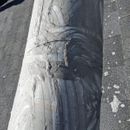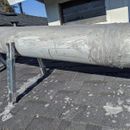External ducting sealing
We had ducting on roof sealed yesterday and two supports done to support ducting …. contractors left the work looking like this. Is this normal?
GBA Detail Library
A collection of one thousand construction details organized by climate and house part











Replies
Not normal, but I think you knew that when posting.
The biggest concern is the way the supports were installed looks like they will cause a roof leak. It looks like they were screwed in straight through the shingle and a bunch of sealant thrown on.
On the duct sealing, mastic should be applied the “thickness of a nickel”. Why is there so much all over places without a duct seam? And why is it all over the roof??
I don’t know what duct sealant is rated for exterior use. What they used looks very thin.
Don’t pay anything.
Where are located? What is the scenario that puts that duct outside?
We are in Los Angeles. An extension built in 1980s... takes heating to the extension because no crawl space for internal ducting apparently. House has recently been renovated and builder’s HVAC company did the ducting (before we bought it and before this work was done) House inspection did not reveal any problem.
This is the duct before the company were called out when there was a leak during rain! The same company did both jobs, we haven’t paid anything ..... what action can we take?
How was water coming in during rain? Was it leaking down the inside of the duct? Could it have been leaking down the outside of the duct?
Are then people that did the sealing work insured? I think they potentially damaged your roof. Hopefully someone else will chime in with the correct way of attaching a support to a shingle roof. They at least did cosmetic damage to the roof.
In generally, ducts outside the building are a bad idea. I don’t know enough about the overall scenario to make a suggestion. At the very least, the duct should be insulated.
Is this really just for heat, or ac as well?
Thank you for your comments... very helpful. The roof is brand new and is still under warranty. The roofer came out and conducted a water test and confirmed the water was coming from inside the duct. That’s when we called them out to check the sealing of the ductwork and the result is shown in the first photographs. At the moment we haven’t got ac but the same duct would be used.....
Who did this work? Hvac or roofer.
Have the roofer come out and confirm if any voiding of the warranty has happened. Get pricing to correctly instal the supports and replace all the dirty shingles.
Hvac did the work. We’re planning to go back to the HVAC contractor tomorrow..... and also get another contractor to review what’s been done and what needs to be done. My faith in ‘professionals’ is disappearing fast!!! How are we the ‘ignorant’ customers supposed to do when being ‘ripped off’ like this!?
I would have expected the “after sealing” pic to look something like the “before” pic you posted, but with a thicker layer of sealant on the joints between duct sections. Possibly more sealant around the roof penetration too where the duct makes a 90 and heads inside.
It looks like they randomly smeared some kind of sealant all over the duct. Very sloppy work, not professional at all, and unlikely to do anything either. The duct support looks like a hastily rigged contraption too, not something properly done. I would have expected to see something built from strut using the adjustable angle brackets.
I agree with the other posters, DO NOT pay these guys. Keep on top of them until things get done properly. There is actually a provision in the code requiring things to be done in a “workmanship like manner”, which means neat and professional. Sometimes things still look a little goofy, especially in retrofit projects, but what you got looks like a toddler did the sealing work. Totally unacceptable. I would never sign off on work like that on any of my own projects.
Bill
>" Totally unacceptable. I would never sign off on work like that on any of my own projects."
+1 - and that's even if the ducts were indoors, inside a vented attic! Exposed to the elements I'd want to see a far more robust duct sealing that that.
I'd personally never sign off on ducts above the roof line- there are too many ways for that to go wrong. I happen to live in a location that can get 10 feet of snow or more in a winter season, but even in less-snowy climes ducts above the roof deck are a terrible "solution" for the long term. At the worst case, even a ridiculously oversized ductless mini-split heat pump solution with the outdoor half of the unit mounted to a small platform or bracket above the roof deck would be preferable to an above the roof deck duct.
That said, I was consulting on what to do with at least one ridiculous duct-sculpture above the (fairly flat) roof about 2 miles from my home in recent years. That was a "mid century modern" house built ~1960 with way too much glass and not enough insulation that had clearly been uncomfortable 10 months out of every year for 55+ years. The homeowners were trying to decide whether to give up and sell at a loss (after investing a huge amount in updated windows), or whether it was fixable. The roof was constantly developing leaks from at the equipment mounting and duct penetrations- the house smelled of mold during the shoulder seasons, and hot bitumen during the cooling season, and the vibration of the AC on the roof when running was jarringly loud making it impossible to sleep with the AC on.
I don't have a handle on what the original heating and cooling loads were back at the time of construction, but when I first saw it there were 9 tons 21st century vintage commercial building type package AC (a 4 tonner and a 5 tonner) and the original 250,000 BTU/hr-in / 200K -out heating plant.
Even though it was another big chunk of change, they built the recommended very low gable roof with 6" of exterior polyiso over the existing roof creating ultra shortattic to house a right-sized 2-stage gas furnace and a right-sized cooling coil. They now have a 2 stage 60,000 BTU/hr -in condensing gas furnace, and 3 or 4 tons of AC (still pretty big for a house that size, but even with the newer better glass the window gains are huge.) Best of all, it's now VERY comfortable all year round. They had me over to dinner just before X-mas, and were remarking on just how radical the transformation. They estimate an 80% reduction in heating fuel use (!), but didn't have a good handle on how much the cooling season electricity savings were. A few years into it the new membrane roof doesn't leak, they don't get ice dams on the roof (even with 3+ feet of snow up there!), and they have to look at the weather report or an outdoor thermometer to tell if it's unusually hot or cold outside- it's THAT stable & comfortable indoors.
I'm not sure their solution applies to this house, but there's nothing right (and everything wrong) with putting ducts above the roof deck when there is ANY other solution possible.
Thanks for your expertise Bill..... we called the owner to come back.... so far not seen him!!
Thanks Dana..... it’s the sloppy unprofessionalism that gets me!!!